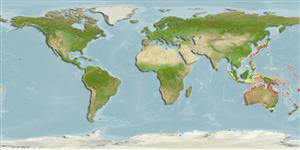Environment: milieu / climate zone / depth range / distribution range
Ecología
marino; salobre. Temperate
Indo-Pacific: around the coasts of Australia and probably throughout the Pacific Ocean as they have been collected as far north as Taiwan and Japan.
Tamaño / Peso / Age
Maturity: Lm ? range ? - ? cm
Max length : 7.5 cm TL macho / no sexado; (Ref. 9769)
Espinas dorsales (total) : 4 - 7; Radios blandos dorsales (total) : 10 - 17; Espinas anales: 1; Radios blandos anales: 20 - 28. Teeth in jaws in single row, covering about half free edge of premaxilla. Two postmaxillary processes scarcely developed.
Most commonly found in surf around rocky headlands and along the shoreline, occasionally also in more still waters of river mouths. Very delicate and do not survive handling. Appear to be able to hybridize with congeners, Iso flosmaris and Iso hawaiiensis. Nothing else is known about this species. (Ref. 9769).
Life cycle and mating behavior
Madurez | Reproducción | Puesta | Huevos | Fecundidad | Larva
Ivantsoff, W., 1999. Isonidae. Surf sardines. p. 2140-2143. In K.E. Carpenter and V.H. Niem (eds.) FAO species identification guide for fishery purposes. The living marine resources of the Western Central Pacific. Volume 4. Bony fishes part 2 (Mugilidae to Carangidae). FAO, Rome. (Ref. 9769)
IUCN Red List Status (Ref. 130435: Version 2024-2)
Threat to humans
Harmless
Human uses
Pesquerías: sin interés
Herramientas
Special reports
Download XML
Fuentes de Internet
Estimates based on models
Preferred temperature (Ref.
123201): 17.9 - 28.7, mean 26.2 °C (based on 983 cells).
Phylogenetic diversity index (Ref.
82804): PD
50 = 0.5625 [Uniqueness, from 0.5 = low to 2.0 = high].
Bayesian length-weight: a=0.00389 (0.00180 - 0.00842), b=3.12 (2.94 - 3.30), in cm total length, based on all LWR estimates for this body shape (Ref.
93245).
Nivel trófico (Ref.
69278): 3.1 ±0.3 se; based on size and trophs of closest relatives
Fishing Vulnerability (Ref.
59153): Low vulnerability (10 of 100).
